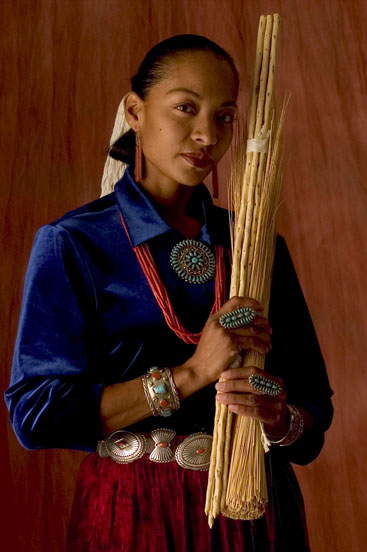 |
Canku Ota
|
 |
|
(Many Paths)
|
||
|
An Online Newsletter
Celebrating Native America
|
||
|
June 1, 2010 - Volume
8 Number 6
|
||
|
|
||
|
Radmilla Cody: Two
Cultures, One Voice
|
||
|
by Felix Contreras -
NPR Music
|
||
|
Her first audience was the sheep. Her inspiration came from what she saw and heard around her. "When you're way out in the middle of nowhere, and you're herding sheep, and you're spending time jumping over the salt bushes and sitting around listening to all the beautiful sounds of nature, something's going to make you open your mouth," Cody says. Cody's voice is bicultural. Her mother was Navajo, her father African-American. Now, she sings folk songs in the language of her Native American ancestors — with a twist. Two
In One That traditional Navajo foundation was augmented by one additional cultural factor: Cody's grandmother was Christian. "I always remember one particular time, the church had this choir from I don't recall where," Cody says. "But man, they sounded so good. And I remember thinking in my mind, 'That's what I want to do, that's what I want to sound like!' " Cody's two cultures come together on her albums. There are traditional songs as well as songs written by her uncle, Herman Cody. Speaking from his home near the center of the 26,000-square-mile Navajo reservation, Herman Cody says the songs he writes for his niece are secular interpretations of sacred ceremonial songs. From the beginning he had one goal. "We're going to make these albums just as grandpa would walk behind the hogan, sit down, start making a moccasin," Herman Cody says. "And then, he just goes at it." That singing usually comes from a man, and it's usually a monotone, with almost no flourishes. Radmilla projects more and uses techniques like bending notes: common among blues, jazz and pop singers.
"She tends to blend both of them in there to where she can sing a traditional song and give it a soulful approach," he says. "That's what makes it sound so unique." It adds what he calls "Navajo soul" to Navajo spirituality. "I think the soul comes in from the black side," Radmilla says, laughing, "and with the Navajo [side], just the beauty and the language in itself." Keeping
The Spirit Alive "The music did not desert me," she says. "It remained there in my life. And I think that in a lot of ways it was because the spirit in those songs knew that I needed — I needed them." Cody says she was afraid to report her boyfriend because he hit her. Today, she lends her voice to help other victims of domestic abuse and to help keep the Navajo language alive. She has her grandmother to thank for that connection to the language. Dorothy Cody is 95 years old now. She still lives in the same house where she raised Radmilla. She says she is proud her granddaughter is taking the Navajo language well beyond the reservation. Radmilla translated for her. "She said it's good," Radmilla says. "She said it's good, you being able to sing in the Navajo language, it's a good thing. And then, of course, you being able to sing in English and speak English is good, too." For Radmilla Cody it comes down to two languages, two cultures and one voice. |
|
|
||
|
|
||
| Canku Ota is a free Newsletter celebrating Native America, its traditions and accomplishments . We do not provide subscriber or visitor names to anyone. Some articles presented in Canku Ota may contain copyright material. We have received appropriate permissions for republishing any articles. Material appearing here is distributed without profit or monetary gain to those who have expressed an interest. This is in accordance with Title 17 U.S.C. Section 107. | ||
|
Canku Ota is a copyright ©
2000, 2001, 2002, 2003, 2004, 2005, 2006, 2007, 2008, 2009, 2010
of Vicki Barry and Paul Barry.
|
||
 |
 |
|
|
The "Canku
Ota - A Newsletter Celebrating Native America" web site and
its design is the
|
||
|
Copyright ©
1999, 2000, 2001, 2002, 2003, 2004, 2005,
2006, 2007, 2008, 2009, 2010
of Paul C. Barry.
|
||
|
All Rights Reserved.
|
||
 Radmilla
Cody says her singing career started in a sheep corral behind her
grandmother's home on the Navajo reservation near Flagstaff, Ariz.
Radmilla
Cody says her singing career started in a sheep corral behind her
grandmother's home on the Navajo reservation near Flagstaff, Ariz.
 Herman
Cody says her voice brings together the traditional and the contemporary.
Herman
Cody says her voice brings together the traditional and the contemporary.